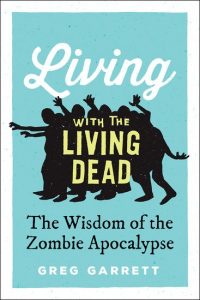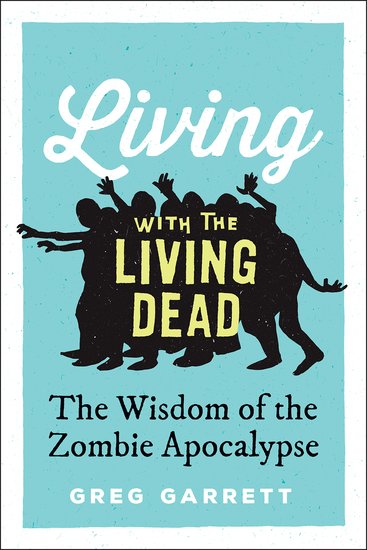by Elizabeth Felicetti
 Living with the Living Dead: The Wisdom of the Zombie Apocalypse by Greg Garrett, Oxford University Press, 2017
Living with the Living Dead: The Wisdom of the Zombie Apocalypse by Greg Garrett, Oxford University Press, 2017
“What you need is a zombie mass,” my husband tells me every year while brainstorming innovative ways to get members of the local neighborhood into church. This makes me cringe more than any of his other crazy ideas. While I’ve allowed myself to be dragged to several zombie movies in our twenty-two years of marriage, I have failed to understand pop culture’s fixation on zombies.
Greg Garrett tackles this question in Living with the Living Dead: The Wisdom of the Zombie Apocalypse: “When I began the book, I wanted to find answers to the question I was regularly being asked, particularly by people over 40: Why are zombies so popular?” (213) As Garrett, an English professor at Baylor University who teaches about pop culture and theology, began researching, he found that the answer was more than a cultural response to the horrors of 9/11, even though over one-third of all zombie movies ever made have been released since 9/11. Images of zombies have been around for hundreds of years, Garrett explains, and can help us address spiritual questions about death, suffering, community, and fear.
Garrett discusses dozens of different depictions of the zombie apocalypse but focuses his book on five works: The Walking Dead; Shaun of the Dead; Zombieland; The Road; and I Am Legend. Some of these include more than one art form (e.g., comic book and television show; book and film). I was surprised by the inclusion of Cormac McCarthy’s Pulitzer-Prize winning The Road, since its ambiguous post-apocalyptic backdrop appears to be related to some sort of nuclear disaster, not zombies; but the book’s themes of cannibalism and violence, and the ethical questions it raises about how far one will go to survive, makes it a good fit for this engrossing study. If you are unfamiliar with any of those works, the plot points are well-explained. Those less familiar with the zombie genre will be surprised by the sheer number and scope of various zombie stories Garrett mentions in the book: a zombie version of Pride and Prejudice exists, for example, as well as a zombie adaptation of the beloved “Archie” comic book series.
Garrett explains that the word “zombie” comes from the Haitian Creole word zonbi, but our current culture’s obsession with zombies began with the movie Night of the Living Dead in 1968, a time of upheaval in the U.S. He notes that critics claim zombie films are more popular and prolific in uncertain times, such as in the late sixties as well as today. Why does this image of the “living dead” resonate?
Garrett links zombies to Ash Wednesday, one of his favorite days of the church year, when Christians are confronted with our mortality. Garrett writes, “When I consume a zombie story, I am confronted with the visceral awareness that I will someday be a corpse” (27). Garrett argues further, “Because these stories take place in this strange borderland between death and life, they may also offer us the wisdom to begin changing our lives now” (33).
Art can be a powerful place to explore big questions. Garrett writes on page 45, “In times of potential extinction, artists and storytellers have clearly seen that confrontations with Death serve a valuable function,” and movingly depicts bleak battlefield landscapes by Paul Nash and poetry by World War I American nurse Mary Borden.
Author of some twenty books, Garrett does not limit himself to art. He also addresses religious questions and themes. “In most faith traditions…we find a set of calls to self-restraint, self-sacrifice, and self-giving that are absolutely not biologically based” (77). Zombies, he points out, are not capable of these ideals.
Chapter two explores how zombie apocalypse narratives encourage community among survivors. After exploring ideas of community in several works, particularly the film Zombieland and the television series The Walking Dead, Garrett turns to Benedictine and Augustinian rules of life, and examines fictional communities threatened by zombies through those monastic lenses.
The final two chapters of the four-chapter book, on ethics and end times, are not quite as tight as the introduction and first two chapters, but they are interesting, with much analysis of McCarthy’s The Road and references to Episcopal priest Scott Bader-Sayre’s teachings on fear. Garrett reminds us that stories of extinction-level events happen in the primeval history of Genesis with Noah’s ark, as well as in the earliest surviving piece of literature, the Epic of Gilgamesh, which also depicts a catastrophic flood. Zombie narratives sometimes lead to nihilism, and sometimes hope.
Perfect for those who want to improve the intellectual depth of their conversations about the latest episode of The Walking Dead, this book also offers appreciable insight into the question Garrett sought to address: “Why zombies?” Some readers with significant pastoral experience will be surprised by the spiritual range of the answer.
The Rev Elizabeth Felicetti is the rector of St. David’s Episcopal in Richmond, Virginia and pursues an MFA in Writing from Spalding University. She tweets @bizfel.

